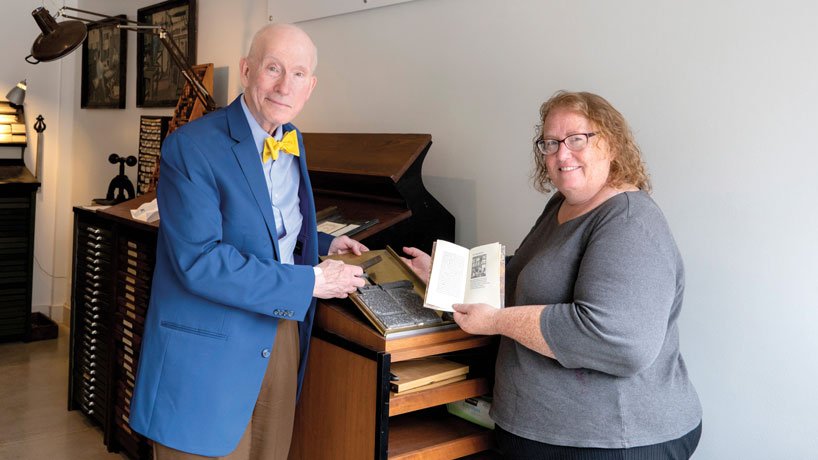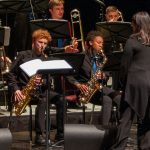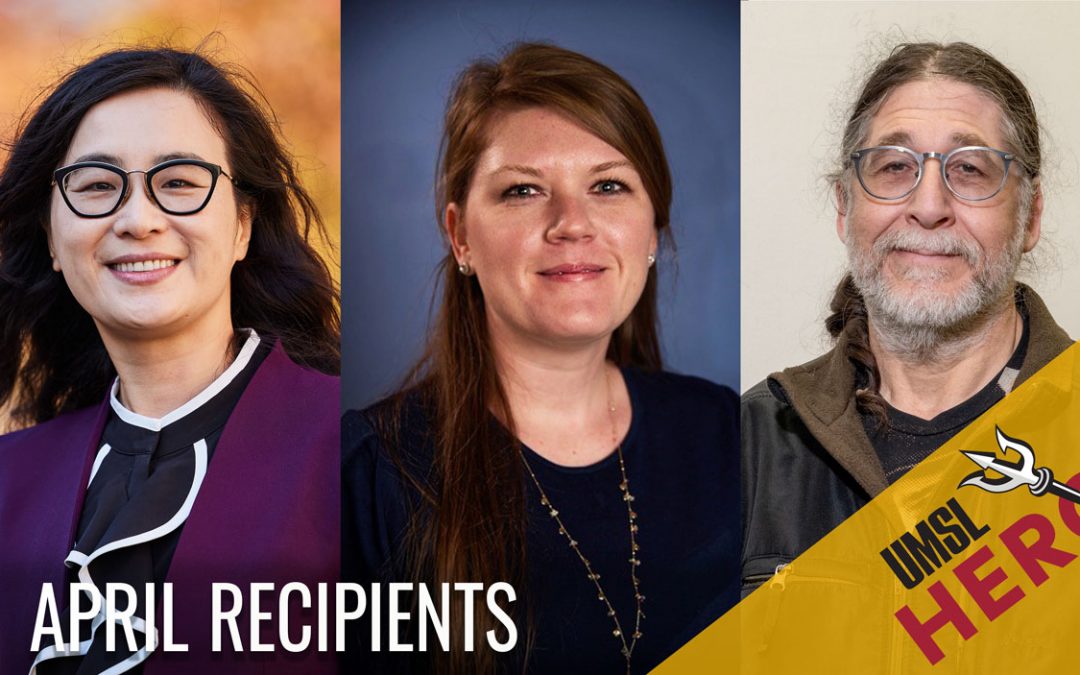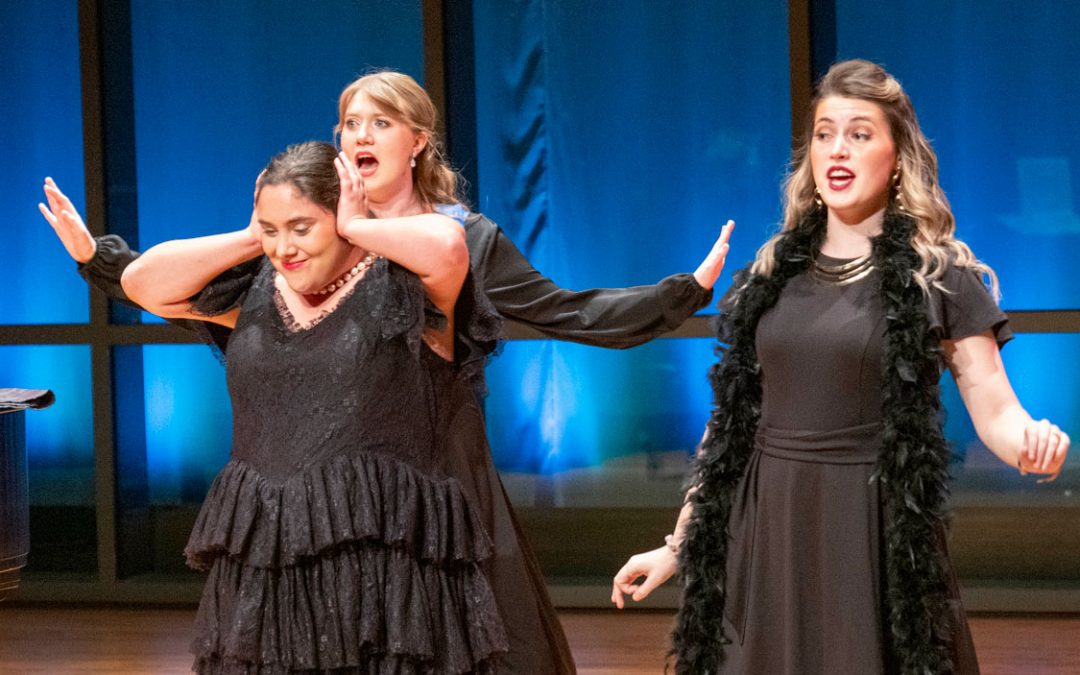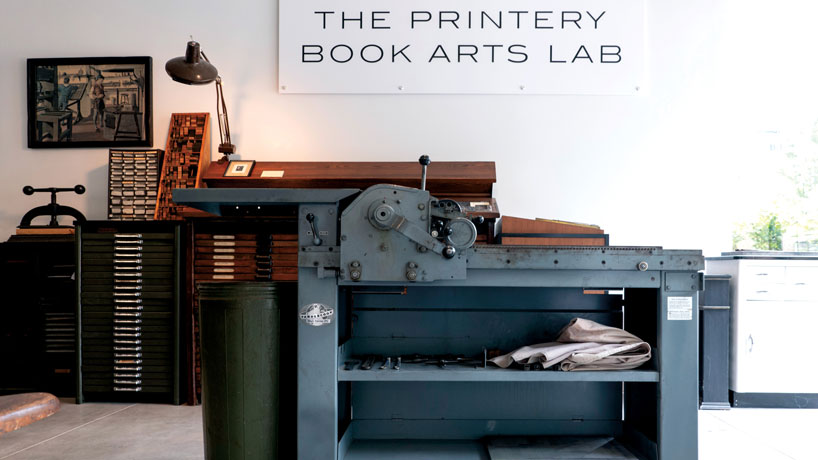
The Printery itself once belonged to distinguished book artist Kay Michael Kramer. (Photo by August Jennewein)
In a sun-dappled corner room inside a printmaking studio in St. Louis’ Old North neighborhood, a historic Vandercook SP15 Test Press sits flanked by cabinets bearing trays and trays of vintage cast metal type pieces. Letters and ornaments in dozens of different typefaces and fonts make their homes in the compartmentalized wooden cases within, from Baskerville and Garamond to Italian Old Style.
This pristine collection of historic typesetting equipment once belonged to Kay Michael Kramer, a fine printer whose framed portrait sits in the studio amid other letterpress equipment including composing sticks and locked-up formes. But thanks to a collaboration between Central Print, a local nonprofit arts organization, and the St. Louis Mercantile Library at the University of Missouri–St. Louis, it’s now accessible to anyone interested in learning about and preserving the art of letterpress.
A distinguished book artist who worked for C.V. Mosby Publishing Company in St. Louis by day, Kramer established The Printery as a private press in the 1970s. From his studio in the basement of his Kirkwood, Missouri, home, he reproduced historic works ranging from the love letters of Eugene Field to Benjamin Franklin’s printing studies.
“He was a great historian of America, and he intended to take that to his press,” says John Neal Hoover, a close friend and the executive director of the St. Louis Mercantile Library. “That’s what these fine printers do – they take something and they make a work of art out of the language and out of the text and out of the type. They explore typography, ornament and color.”
Hoover, a rare book librarian, and Kramer would frequently work together on projects, with Kramer utilizing illustrations or text from the Mercantile’s vast, historic collection for the books, greeting cards and other items he produced using The Printery. Today, many of his works – a Christmas card featuring “Stopping by Woods on a Snowy Evening,” for instance – are available in the Mercantile Library’s collection for students to study.
When Kramer’s health later took a turn for the worse – he ultimately passed away in 2021 – he and his wife, Ginny, considered ways to keep the legacy of The Printery alive. It was an obvious decision for them to locate the press in the Mercantile Library, but Hoover had a better idea.
“Kay’s equipment is so large, and you’d need a true lab with heavy floors for that kind of printing equipment from older times,” he says. “And I thought it would be better to actually collaborate with Central Print to let the Mercantile acquire the equipment and then put it in a place, on extended loan, where there are programs, steady availability and an actual setting for a lab where people can enjoy the press, use it, learn about Kay and learn about The Printery.”
And that’s just what Central Print is doing with this historic equipment.
Since 2019, Central Print, which was founded in 2014 to promote letterpress and book arts, has operated The Printery Book Arts Lab inside its north St. Louis facility. Visitors can make use of the pristine equipment and extensive type collection during various programs, and Central Print also offers a residency program that provides access to the printmaking studio for two weeks.
John Neal Hoover, the executive director of the St. Louis Mercantile Library, and Marie Oberkirsch, the executive director of Central Print. (Photo by August Jennewein)
Executive Director Marie Oberkirsch says they were excited to be able to utilize the equipment, particularly because it includes such a comprehensive collection of type and ornaments.
“It’s very unique, especially to the region,” she says. “The thing that’s really special about the collection is for anyone to have enough type to be able to print a book, it has to be a tremendous volume and comprehensive. They might need an italic for a footnote, as you can imagine, which means that you have to have both the typeface and the italic in multiple sizes. It’s really a large quantity of pristine typesetting equipment, and we are thrilled to have access and provide access.”
Scott Gericke, an assistant teaching professor in the Department of Art and Design at UMSL and a Central Print board member, frequently makes use of access to Central Print’s facilities. Each spring, he brings his Type 2 students to the Gericke says incorporating the art of letterpress, studio to learn about fine book printing processes and incorporate some of those techniques and tools into their own work. He and his colleagues, professor Jennifer McKnight and assistant teaching professor Elizabeth Buchta, continue to find ways to use the equipment to engage students and each other. Gericke, who utilized Central Print’s equipment for a recent St. Louis Magazine cover package, says using the letterpress lends a quality and texture to the type that just can’t be replicated on a computer.
For one of the projects in his curriculum, students print different letters, numbers, punctuation marks and symbols on a letterpress and then digitize them on a computer. Eventually, he’d like students to master the letterpress enough to hand-set a paragraph of text for a book page or a poem. Gericke says incorporating the art of letterpress, whether through the resources at Central Print or the department’s own on-site press, sets the UMSL Art and Design program apart.
“Most students grew up with technology when they were super young, so they have no clue about how things were printed before the computer came along,” he says. “And I think they appreciate it. The work they’ve done is really cool and really different. It sets our students’ portfolios apart when they are using equipment that isn’t technologically advanced in the way it produces things like a laser printer. It’s a nice tool for them to have in their toolbelts.”
And that’s exactly what Hoover had hoped for, not just in acquiring The Printery but for furthering the overall mission of the Mercantile Library, too.
“To see the collections, including The Printery, preserved, come alive and used for the good of the students and the faculty here is exactly why we wanted this affiliation with UMSL,” he says. “When I see students having access to a private press like Kay’s, thanks to the help of the Mercantile, that makes me feel as if the Mercantile continues to thrive into another century, and I’m very happy about that.”
For information on classes and workshops at Central Print, visit centralprint.org.
This story was originally published in the fall 2022 issue of UMSL Magazine. If you have a story idea for UMSL Magazine, email magazine@umsl.edu.

